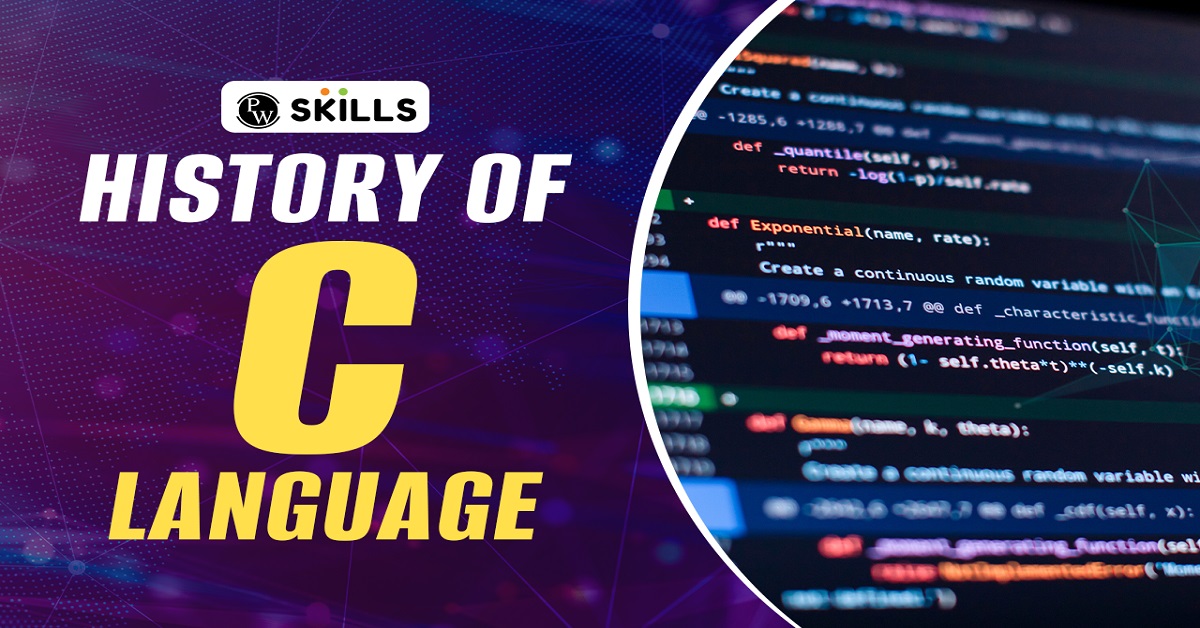C Programming Language History is very interesting. You will learn about the C programming language’s history, timeline, and invention. Keep reading to know more!
C Programming Language History: Dennis Ritchie created the C programming language in 1972 at AT&T Bell Laboratories in the USA, originally intended for system implementation.
Over time, it has evolved into a versatile and enduring high-level language, serving as the cornerstone for numerous advanced programming languages. This attribute is why this resilient language is commonly acknowledged as the ‘mother of programming languages.’ Throughout this article, you will gain insights into the history of the C language and the other languages that paved the way for its development.
What is C Programming Language?
C is a widely embraced general-purpose programming language cherished for its simplicity and versatility. Renowned for its structured programming paradigm, C possesses the valuable trait of machine independence. Its applications span diverse domains, encompassing various software development, Operating Systems such as Windows, and intricate programs like Oracle databases, Git, Python interpreters, and more.
Often dubbed the “god’s programming language,” C is the cornerstone of programming. Proficiency in ‘C’ lays a solid foundation for understanding other programming languages that leverage the principles established by ‘C.’
A fundamental comprehension of computer memory mechanisms proves to be crucial when engaging with the C programming language. This understanding adds depth to one’s ability to navigate and harness C’s power effectively.
This unique attribute positions C as an efficient middle-level programming language. Its close relationship with hardware further renders it well-suited for endeavors in low-level development, spanning operating system creation, kernel development, embedded systems, and more. C is optimal for intricate data manipulation applications, such as database development and 3D animation.
Also Read: What is C?
C Programming Language History Explained
Here’s a concise history of the C programming language, outlining the lineage of programming languages leading up to C’s inception. You can also download history of C language PDF to get instant access!
- The roots of the C programming language can be traced back to its precursor, ALGOL 60 (algorithmic language), introduced in 1960 as the first programming language employing a block structure. Derived from ALGOL, Martin Richards developed BCPL (Basic Combined Programming Language), a typeless high-level language.
- The C language developed by Dennis Ritchie in 1972. In 1970, Ken Thompson built upon BCPL to create a typeless language called B. Subsequently, Dennis Ritchie at AT&T Bell Labs took charge of the C language’s development in 1972, drawing inspiration from the foundations laid by BCPL and B.
- Initially used to re-implement the Unix operating system, C gained popularity for its portability and efficiency. The Unix operating system, initiated in 1969, underwent a rewrite in C in 1972.
- The release of Windows 1.0 in 1985, while not publicly disclosing its source code, reportedly featured a kernel predominantly written in K programming language.
- Linux, a prominent operating system, commenced development in 1991 using C and Lisp. After nearly a year of development, Linux was released under the GNU license, forming part of the GNU operating system.
- Oracle, a widely-used relational database management system (RDBMS), began development in 1977. In 1983, its code transitioned from assembly language to the C programming language (3rd edition).
- To establish C as a standard, the American National Standards Institute (ANSI) defined a commercial standard for the language in 1989. Subsequently, this standard gained approval from the International Standards Organization (ISO) in 1990, leading to the term “ANSI C.”
Make C programming language history notes to understand its history and origin clearly. C++, Java, and other languages have evolved from C, finding widespread application in various technologies. As such, C serves as a foundational language for many others currently in use.
Who Invented C++ and C?
Dennis Ritchie created the C programming language at Bell Labs in the early 1970s. Ritchie developed C as an evolution of the B programming language, which Ken Thompson created. C became widely popular due to its efficiency, portability, and versatility. Dennis Ritchie is often regarded as the primary inventor of the C programming language.
C++, an extension of the C programming language, was invented by Bjarne Stroustrup. A Danish computer scientist, Stroustrup, developed C++ at Bell Labs in the early 1980s. C++ introduced object-oriented programming features to C, adding classes, inheritance, polymorphism, and other enhancements. Bjarne Stroustrup is credited as the inventor of C++.
What Language is C a Successor of?
C is a successor to the programming language B, developed at Bell Labs by Ritchie between 1972 and 1973 for Unix utilities. It succeeded the B language and was initially created for coding in the Unix operating system.
C Programming Language History Timeline
The below table outlines key releases and developments in the C programming language, showcasing its evolution over the years.
| C Programming Language History Timeline | ||
| Year | Version | Description |
| 1972 | C | C was first released. |
| 1978 | K&R | The first edition of “The C Programming Language” book by Brian Kernighan and Dennis Ritchie, often referred to as K&R C. It served as a reference until a formal standard was established. |
| 1989 | C-89/ ANSI C | ANSI standardized the language (ISO/IEC 9899:1990), introducing standard libraries and features like function prototypes, void pointers, etc. |
| 1990 | C-90 | Minor updates and fixes on C89. |
| 1999 | C-99 | Support for variable length arrays, new data types, and inline functions (ISO/IEC 9899:1999). |
| 2011 | C-11 | Introduction of additional data types, multi-threading, and improved Unicode (ISO/IEC 9899:2011). |
| 2018 | C-18 | Minor updates and fixes on C11 (ISO/IEC 9899:2018). |
It’s important to acknowledge that while these represent the official versions of the C language, the extent of support for these versions can vary among different compilers and platforms. Furthermore, certain widely utilized features in C programming, like the preprocessor, are not explicitly outlined in the official language standard.
It’s worth noting that some individuals regard C-90 and C-89 as essentially the same, given the relatively minor differences between the two versions. Similarly, while some may mention C17 instead of C18, the 2018 version stands as the most recent standard as of the knowledge cutoff of this model.
Also Read: C Programming Tutorial
How Does C Programming Work?
C language serves as a compiled programming language extensively utilized for system programming, embedded systems, and various low-level applications. The creation and execution of a C program involve several sequential steps, encompassing preprocessing, compiling, linking, and execution.
1) Program Creation:
Initiating the use of C begins with program creation. This entails crafting the source code in a text editor or integrated development environment (IDE), constituting a set of raw instructions that delineate the program’s behavior.
2) Preprocessing:
Following program creation, preprocessing becomes imperative. This phase incorporates running the source code through a preprocessor—an application executing specific operations on the code before compilation. Operations may include inserting header files, expanding macros, and performing conditional compilation.
3) Compiling the Program:
Subsequent to preprocessing, the program undergoes compilation. This process involves translating the source code into machine code executable by the computer’s processor. The compiler reads the source code and generates an object file containing the compiled code.
4) Linking the Program with C Library Functions:
Post-compilation, linking ensues, necessitating the program to be linked with functions from the C library. The C library comprises prewritten functions accessible to C programs. Linking amalgamates the object file produced by the compiler with the essential functions from the C library, culminating in an executable program.
5) Executing the Program:
The concluding step entails program execution. The executable file, fashioned in the preceding step, is run by the operating system. The operating system loads the program into memory, initiating its execution. The program proceeds to perform its designated operations until termination or interruption occurs.
Key Applications of C Programming Language
The C programming language finds diverse applications across various domains due to its efficiency, flexibility, and low-level capabilities. Some key applications of the C programming language include:
- Embedded Systems: C is a popular choice for programming embedded systems, which are specialized computing devices designed for specific functions. Examples include microcontrollers in electronic devices, automotive systems, and industrial machines.
- Database Management Systems (DBMS): C is employed in the creation of database management systems. Its ability to handle memory efficiently and perform low-level operations is crucial for optimizing data storage and retrieval processes.
- Network Drivers and Protocol Stacks: C is utilized in the development of network drivers and protocol stacks, facilitating communication between hardware devices and network protocols. This is crucial for enabling network connectivity in operating systems.
- Web Development: While high-level languages are more commonly used for web development, C can be utilized in server-side applications and to optimize certain performance-critical components.
- Scientific and Mathematical Applications: C is employed in scientific computing and mathematical modeling applications. Its efficiency in handling numerical calculations and computational tasks makes it a choice for simulations and scientific research.
Financial Applications: C is utilized in developing financial applications and algorithmic trading systems. Its speed and reliability are crucial in handling large volumes of financial data and executing complex algorithms in real-time.
C Programming Language History FAQ's
When was the C Programming Language first released?
The C Programming Language was first released in the year 1972.
What is K&R C?
K&R C refers to the first edition of "The C Programming Language" book published by Brian Kernighan and Dennis Ritchie in 1978. It served as a reference for the language until a formal standard was established.
When did ANSI standardize the C Programming Language?
The American National Standard Institute (ANSI) standardized the language in 1989, resulting in the C-89 version (ISO/IEC 9899:1990). This marked the introduction of standard libraries and features like function prototypes.
What updates were introduced in C-90?
C-90, released in 1990, brought minor updates and fixes to the C89 version.
What features were added in the C-99 version?
C-99, released in 1999 (ISO/IEC 9899:1999), introduced support for variable length arrays, new data types, and inline functions.






